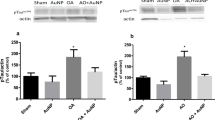Abstract
Objective: To observe the effect of Tiaoxin Recipe (TXR) on the spatial memory, brain mitochondrial energy metabolism of oxidation injured Alzheimer’s disease (AD) rats, and to explore the mechanism of TXR in treating AD.Methods: Eighty-eight SD rats were randomly divided into five groups (normal group, operative group, “AD” model group, TXR group and Aricept group). An oxygen free radical generation system (dihydroxy fumaric acid-trichloroferric-adenosine diphosphate, DHF-FeCl3-ADP) was used to create oxidation injured rat models mimic to AD; spatial learning and memory impairment (Morris water maze method), the activity of Succinate-oxidase, NADH-oxidase, CytC-oxidase (Clark oxygen electrode method) and the expression of cytochrome oxidase (CO) II mRNA (in situ hybridization method) were observed.Results: Compared with the normal group, the spatial memory, activity of CytCoxidase and COII mRNA expression of oxidation injured “AD” rats were obviously decreased; TXR, however, could improve these functions in “AD” rat models obviously.Conclusion: The mechanism of the action of TXR in treating AD was partly related to its effect on anti-oxidation which could improve brain mitochondrial energy metabolism.
Similar content being viewed by others
References
LI YM, ZHANG CY, LIN SM. Theoretical exploration on Xin-benefiting and Shen-tonifying method in treating AD. J Gansu College TCM 2000;17(2): 1–3.
LIN SM. Clinical research on the effect of TXR on Alzheimer’s disease. J Shanghai Univ TCM 1997; 11(1): 44.
Morris RJ. Developments of a water-maze procedure for studying spatial learning in the rats. Neurosci Methods 1984;11: 47–60.
Zini R, Morin C, Bertelli A, et al. Effect of resveratrol on the rat brain respiratory chain. Drugs Exptl Clin Res 1999;XXV(2/3): 87–97.
Heinz S, John JL, Matthias H, et al. Liposome-mitochondrial inner membrane fusion. J Biochem 1980; 255(8): 3748–3756.
Nancy A, Simonian NA, Hyman BT, et al. Functional alterations in Alzheimer’s disease: selective loss of mitochondrial-encoded cytochrome oxidase mRNA in the hippocampal formation. J Neuropathol Exp Neurol 1994; 53 (5): 508–512.
Meier Ruge W, Iwangoff P, Bertoni Freddari C, et al. What is primary and what is secondary for amyloid deposition in Alzheimer’s disease. Ann NY Acad Sci 1994; 719: 23–27.
Mecocci P, MacGarvey U, Kaufman AE, et al. Oxidative damage to mitochondrial DNA shows marked age-dependent increases in human brain. Ann Neurol 1993; 34: 609–616.
Author information
Authors and Affiliations
Corresponding author
Additional information
This program was supported by National Natural Science Foundation of China (No. 39830450)
Rights and permissions
About this article
Cite this article
Hong, Q., Guo-qin, J., Wei-kang, Z. et al. Effect of Tiaoxin Recipe on spatial memory and energy metabolism of oxidation injured Alzheimers disease rats. Chin. J. Integr. Med. 9, 44–48 (2003). https://doi.org/10.1007/BF02836355
Received:
Issue Date:
DOI: https://doi.org/10.1007/BF02836355




